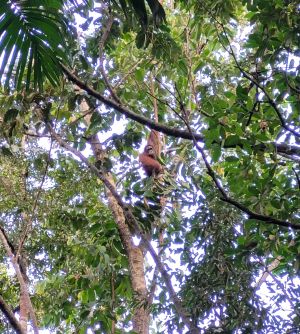Northwest Bornean Orangutan
Range countries
Indonesia, Malaysia
Population status
The Northwest Bornean orangutan (Pongo pygmaeus pygmaeus), one of the three Bornean orangutan subspecies, has the smallest geographic range (Wich et al. 2008, Wich et al. 2012). Northwest Bornean orangutans inhabit West Kalimantan (Indonesia) from north of the Kapuas River to the eastern region of Sarawak (Malaysia). Key populations are concentrated in the following protected areas: the Batang Ai National Park and the Batang Ai-Lanjak-Entimau (BALE) landscape in Sarawak; and the Betung Kerihun and Danau Sentarum National Parks in West Kalimantan (Wich et al. 2008). Additionally, two smaller populations located in the Ulu Sebuyau National Park and Sedilu National Park in Sarawak were officially designated as protected areas in 2010 (Ancrenaz et al. 2016). All subspecies of Bornean orangutans are declining (Voigt et al. 2018).
It has been estimated that there are fewer than 10,000 individuals remaining in Sarawak and West Kalimantan (Wich et al. 2008). Northwest Bornean orangutans are classified as Critically Endangered on the IUCN Red List of Threatened Species (Ancrenaz et al. 2016). Encounter rates for this subspecies have decreased six-fold over the past 150 years, even in forested areas, suggesting that factors like hunting are driving population declines (Meijaard et al. 2010). The subspecies is declining rapidly, with climate and land-use changes expected to further accelerate habitat losses (Struebig et al. 2015).
Threats
Despite several significant populations residing in protected areas, illegal hunting poses a major threat to their survival across much of their range (Abram et al. 2015). Moreover, a large number of orangutans in the western part of West Kalimantan have been lost due to recent forest conversion for oil palm agriculture and poaching (Abram et al. 2015). Between 2000 and 2010, Borneo experienced an average annual deforestation rate of 3,234 km² (Gaveau et al. 2014). If this rate continues, projections suggest substantial forest loss: 32,000 km² by 2020, 129,000 km² by 2050, and 226,000 km² by 2080 (Wich et al. 2015). Only populations in the Lanjak Entimau/Batang Ai complex and Betung Kerihun National Park are relatively secure, while the majority of orangutans in low-lying swamp and lowland Dipterocarp forests face significant threats from habitat loss, conflict, and hunting. In Sarawak, two small populations are now confined to protected peat swamp forests in Sebuyau and Sedilu (Ancrenaz et al. 2016).
Conservation activities
The Bornean Orangutan receives full legal protection in Malaysia and Indonesia, being listed on Appendix I of CITES. The fate of these orangutans relies heavily on the stability of vast, rigorously protected forested areas where illegal activities such as logging and hunting are effectively controlled, and where orangutan populations demonstrate resilience against catastrophic occurrences like fires and disease outbreaks (Meijaard et al. 2011). These forests must encompass diverse ecological gradients that offer essential resources to support orangutans amidst changing climates and environmental conditions (Gregory et al. 2012). On a larger scale, it is imperative to undertake science-driven regional land-use planning to define interaction zones surrounding protected forests and their environs, taking into account hydrological, ecological, and socio-economic considerations (Ancrenaz et al. 2016).
References
Abram, N.K., Meijaard, E., Wells, J.A., Ancrenaz, M., Pellier, A.S., Runting, R.K., Gaveau, D.L.A., Wich, S., Nardiyono, Tiju, A., Nurcahyo, A., & Menkersen, K. (2015). Mapping perception of species’ threats and population trends to inform conservation efforts: The Bornean orangutan case study. Diversity and Distributions, 21, 487–499.
Ancrenaz, M., Gumal, M., Marshall, A.J., Meijaard, E., Wich , S.A. & Husson, S. (2016). Pongo pygmaeus ssp. pygmaeus. The IUCN Red List of Threatened Species 2016: e.T39781A17990445. https://dx.doi.org/10.2305/IUCN.UK.2016-1.RLTS.T39781A17990445.en. Accessed on 26 January 2024.
Gaveau, D.L.A., Sloan, S., Molidena, E., Yaen, H., Sheil, D., Abram, N.K., Ancrenaz, M., Nasi, R., Quinones, M., Wielaard., N., & Meijaard, E. (2014). Four decades of forest persistence, loss and logging on Borneo. PLoS One, 9(7), e101654.
Gregory, S.D., Brook, B.W., Goossens, B., Ancrenaz, M., Alfred, R., Ambu, L.N., & Fordham, D.A. (2012). Long-term field data and climate-habitat models show that orangutan persistence depends on effective forest management and greenhouse gas mitigation. PLoS One, 7(9), e43846.
Meijaard, E., Buchori, D., Hadiprakarsa, Y., Ancrenaz, M., et al. (2011). Quantifying killing of orangutans and human-orangutan conflict in Kalimantan, Indonesia. PLoS One, 6(11), e27491.
Meijaard, E., Welsh, A., Ancrenaz, M., Wich, S., Nijman, V., & Marshall, A.J. (2010). Declining orangutan encounter rates from Wallace to the present suggest the species was once more abundant. PLoS One, 5(8), e12042.
Struebig, M.J., Fischer, M., Gaveau, D.L.A., Meijaard, E., Wich, S.A., Gonner, C., Sykes, R., Wilting, A., & Kramer-Schadt, S. (2015). Anticipated climate and land-cover changes reveal refuge areas for Borneo's orang‐utans. Global Change Biology, 21, 2891–2904.
Voigt, M., Wich, S. A., Ancrenaz, M., Meijaard, E., Abram, N., Banes, G. L., ... & Kühl, H. S. (2018). Global demand for natural resources eliminated more than 100,000 Bornean orangutans. Current Biology, 28(5), 761-769.
Wich, S. A., Meijaard, E., Marshall, A. J., Husson, S., Ancrenaz, M., Lacy, R. C., ... & Singleton, I. (2008). Distribution and conservation status of the orang-utan (Pongo spp.) on Borneo and Sumatra: how many remain?. Oryx, 42(3), 329-339.
Wich, S.A., Gaveau, D., Abram, N., Ancrenaz, M., Baccini, A., et al. (2012). Understanding the impacts of land-use policies on a threatened species: Is there a future for the Bornean orangutan? PLoS One, 7(11), e49142.
Wich, S.A., Singleton, I., Nowak, M.G., Utami Atmoko, S.S., Nisam, G., Arif, S.M., Putra, R.H., Ardi, R., Fredriksson, G., Usher, G., Gaveau, D.L.A., & Kühl, H.S. (2016). Land-cover changes predict steep declines for the Sumatran orangutan (Pongo abelii). Science Advances, 2(3), e1500789.
Last updated January 2024
